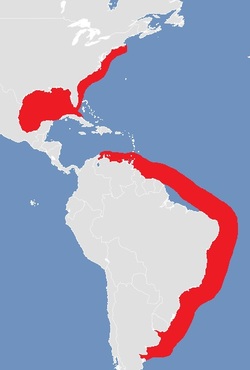
Common Name
Sharpnose Sevengill Shark
Year Described
Bonnaterre, 1788
Identification
An elongate shark with a pointed snout, large eye, and a narrow mouth. Dorsal fin inserted far back on body (posterior to origin of pelvic fin) and fairly small. Pelvic fins larger than dorsal and anal fins, with a very long base. Anal fin small, just posterior to pelvic fin. Pectoral fin large and inserted low on body. Caudal fin fairly large with a strong subterminal notch and well developed ventral lobe. There are seven large gill slits with the first one being the longest and the last one anterior to the pectoral base. The lower jaw contains five rows of comb-like teeth and the upper jaw has narrow, hook-like teeth with small lateral cusplets.
Color
Adults brownish-gray to olive-brown with a paler underside. There may be occasional dark spots on the body. Fins may have pale margins. Juveniles may have darker blotches and dark tips to the dorsal and caudal fins. Eyes are blue-green in life.
Size
Commonly from 60-120 cm. in length. Maximum size 140 cm. Males mature at a smaller size than females.
Habitat
Mostly benthic from 27-1000 m. on outer continental slope waters (may occur around islands too). Can be found close to the surface at night. It is an active predator on invertebrates and fishes. Ovoviviparous (9-20 young).
Range Map

Range
North Carolina to Florida on the Atlantic coast, Florida to the Yucatan in the Gulf of Mexico. In the Caribbean it has been reported from northern Cuba and Jamaica but not elsewhere (McLaughlin & Morrissey, 2004). On the South American coast it occurs from Venezuela to Argentina.
References
Castro, J.I. 2011. The Sharks of North America. Oxford University Press, 640 pp.
Compagno, L., M. Dando, and S. Fowler. 2005. Sharks of the World. Princeton University Press, 480 pp.
McLaughlin, D. M. and J. F. Morrissey. 2004. New records of elasmobranchs from the Cayman Trench, Jamaica. Bulletin of Marine Science 73(3): 481-485.